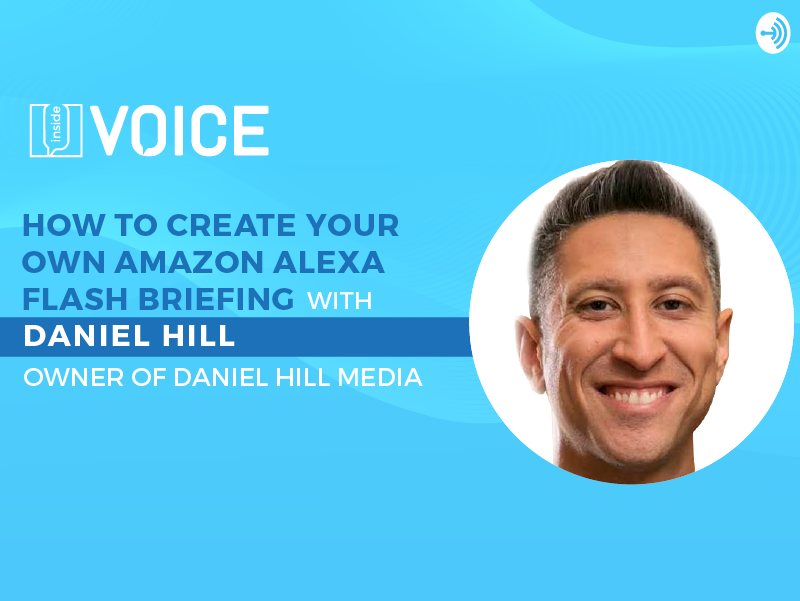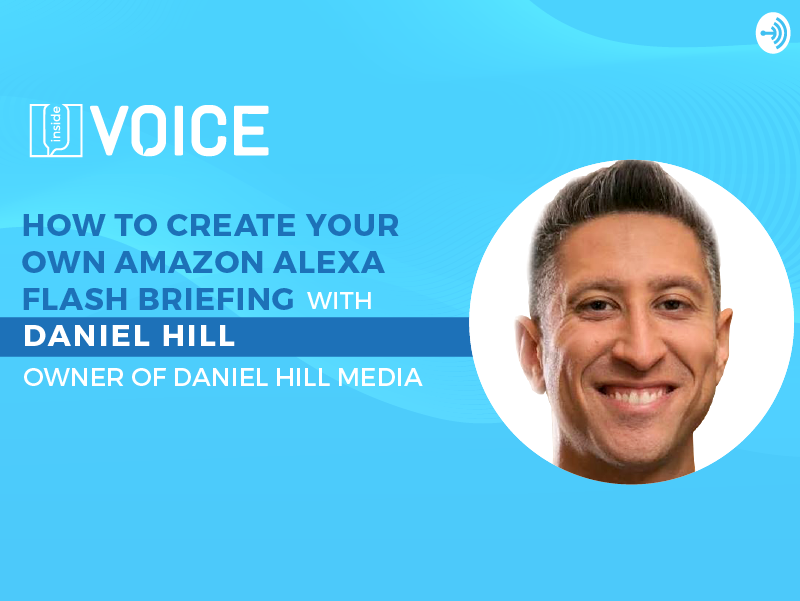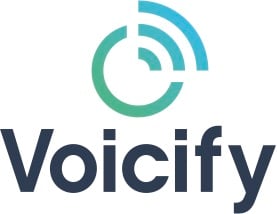
Create Your Own Alexa Flash Briefing in Five Easy Steps

If you want to build an audience in the voice-first world, Alexa flash briefings are the way to go.
From long and insightful podcasts to short and impactful microcasts, content producers are turning to Alexa to regularly deliver useful tidbits and expert tips to an engaged audience.
But, how do you know if you need one? How can you set one up without technical knowledge? And what does a flash briefing strategy even look like?
Daniel Hill has first-hand experience with all of these questions. As an experienced social media consultant, he discovered Alexa as a better way to teach people how to build a following on Instagram. After his own fair share of questions and research, he now produces a successful two-minute Alexa flash briefing with over 21,000 subscribers—all earned in less than a year.
To learn what Daniel knows about Alexa flash briefings, Keri Roberts picked his brain on Episode 59 of the Inside Voice Podcast. In the episode, Daniel breaks down how to plan your own flash briefing, and how to get it up and running in five (very doable) steps.
It's incredibly helpful stuff, but since many of you have tight schedules, we listened to the podcast and skimmed the most important bits you need to know. Read on.
Why create an Alexa flash briefing?
"If you have something that you want to get out to an audience but you don't have the time, energy or resources to run a podcast—a flash briefing is a great way to get started."
This is the simple reasoning behind Daniel's own flash briefing, and what he thinks is all you need to think about before deciding whether you (or your business) should start one too.
If you're not completely certain on what a flash briefing even is, Daniel briefly explains that it's like having a few minutes of airtime on Alexa devices. In the same way that people ask Alexa, "tell me the news," and listen to a few minutes of whatever CNN and NPR has to say; you can add your own segment to Amazon so people can subscribe to it and hear it on their Alexa during their daily briefing.
"It doesn't cost you anything to make and you can get started very, very quickly," Daniel says confidently, then comments that people can find your flash briefing through search terms on Amazon.com and add it to their daily Alexa routine.
"You become part of their morning and they rely on you as a source for that specific information," he explains, concluding that flash briefings are also an opportunity to introduce people to something important that you're doing—like a book or a course.
"It's a great opportunity to grow an audience from very, very little; and learn a new platform that I think is only going to become more important over time."
How to map your flash briefing
There are a few stages to mapping out your own Alexa flash briefing. Unless you already know exactly what to talk about, here are four steps Daniel recommends to help you define a solid strategy for your flash briefing.
1. Find a topic you can talk about
The Alexa flash briefing market is surprisingly scarce. Daniel reveals that there are only about 9,000 available, and not all of them are active. In fact, the video games category has exactly one flash briefing. But while some topics are wide open, others are definitely crowded.
So, Daniel says the first thing you should do is look for a topic on Amazon that doesn't have too many flash briefings already. Then, narrow it down to a specific topic that you feel comfortable enough talking about in small doses. "You don't have to be an expert," Daniel says reassuringly. "You just have to be interested in it and search for news you can talk about for a few minutes."
He adds that by sharing these spoonfuls of knowledge on a daily basis, you can become an authority on the topic fairly quickly.
2. Define the length and publishing frequency
Alexa flash briefings are designed for busy people to learn something new and move on with their day. Daniel says most people prefer a quick shot of information over lengthy podcasts, which he knows from experience since people usually drop off his own podcast after the 12 - 15 minute mark.
In short: an Alexa flash briefing should only last between 1 - 4 minutes. As for publishing frequency, Daniel recommends pushing out new content "at least five days a week," especially if you're doling out newsworthy updates.
3. Outline the content
Whether you're sharing the latest news or giving educational tips on a specific topic, you don't want to spend half the time scrambling for something to talk about.
"I personally use Google RSS feeds," Daniel says, "I set up a Google Alert for the word 'Instagram,' so every day I either get an email with all the top stories about Instagram or I can see them in my RSS feeds."
He adds that platforms that support flash briefings also let you schedule posts ahead of time, so if you find multiple topics to talk about, you can record and schedule several posts to spare yourself from worrying about publishing the rest of the week. (We'll discuss flash briefing platforms in a moment.)
4. Find extra platforms to publish on
As someone who works with short-lived Instagram stories, Daniel is very aware of how annoyingly brief a content's life-span can be. On Amazon Alexa, each new post overrides the previous one, and once it's gone, it's gone.
To keep your content available online for anyone looking to catch up on your flash briefings, Daniel recommends publishing on other platforms like Spotify, iTunes, or Google Play Music.
How to publish your Alexa flash briefing
Now this is the best part. During his journey to create his own flash briefing, Daniel has kindly condensed the process for us into five steps:
1. Register for a developer account
To get started, Daniel says to go into Amazon Developer and register for a developer account (you can use your same Amazon email). Don't worry, you won't have to write any code. The title is just the trench coat you need to wear to gain access to the prestigious option of creating a flash briefing skill.
2. Choose a flash briefing hosting provider
This is where you pick the company in charge of hosting your flash briefing skill. You can choose your own website, if it's secured with SSL, or even Dropbox. The default option is Amazon Web Services (AWS), but Daniel uses a company called effct.co, which provides free hosting (but paid scheduling).
3. Submit your flash briefing for approval
Create and name your first flash briefing, copy the feed address within the provider you're using, and post it in your new Amazon Developer account under Flash Briefings. Once it's there, Amazon will carry it through an approval process. Daniel says it usually takes between 1 - 3 days to get approved, but expect to wait a bit longer around the holidays.
4. Record your first flash briefing post
Now it's time to get the actual content up. If you have your own recording studio, great, but you don't need one to capture audio in good quality.
"A lot of people just do it on their phone," Daniel says. He and many other flash briefers admit to simply burrowing themselves inside a full closet (for extra soundproofing) to record. A carpeted room with lots of pillows around is another good alternative.
Wherever you choose to record, what's actually important is what you do afterwards. Some people just upload their raw recording as is, while others fiddle with editing tools to add intro and outro music.
"Decide what feels right to you," Daniel recommends, "but make sure you're not burdened by it." He also suggests that a long editing process is a sure sign you need to simplify your recording routine.
5. Submit your post for approval and publish
Once you're happy with your post, save it as an MP3 and upload it to whatever hosting platform you chose in step two. Back in your Developer account, submit your post for approval (you only need to do this for the first post), and voilà. Your post is ready to be heard by everyone who enables your flash briefing.
Listen to the episode
As much as we love having you read our posts, nothing really beats listening to the original. So if you have a 20-minute gap in your commute or lunch break, definitely check out Daniel Hill's episode on Inside Voice to hear all the extra details and anecdotes in his own words.
Helpful information like this is what VOICE is all about, and Daniel has become one of our favorite speakers at VOICE Summit—where the community comes together to learn and network. If you want to meet him in person (along with hundreds more voice-first entrepreneurs) make sure to RSVP to our next VOICE Summit! We'll send an email when tickets are up for grabs.







.png)

